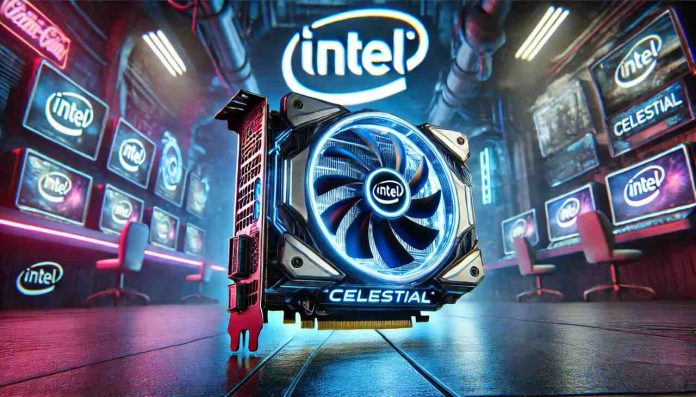Could Intel Finally Disrupt the GPU Market with Its Rumored Xe3P Architecture?
Intel has been making steady progress in the GPU market, with its Arc Battlemage GPUs gaining traction among budget-conscious PC gamers. Now, new reports suggest that Intel’s upcoming ‘Celestial’ GPUs could be a major step forward, potentially challenging AMD’s Radeon and Nvidia’s GeForce RTX series.
Key Takeaways:
- Intel’s Celestial GPUs may feature the new Xe3P architecture, moving beyond the current Xe3.
- Intel might use its own INTC in-house process instead of relying on TSMC, giving it more control over chip production.
- A shift to in-house manufacturing could accelerate production and improve GPU availability.
- Speculated improvements include AI upscaling, better power efficiency, and next-gen frame generation technology.
What We Know About Intel’s ‘Celestial’ GPUs
A New Architecture: Xe3P for Enhanced Performance
Intel’s Arc Battlemage GPUs, such as the Arc B580 and Arc B570, have proven to be strong contenders in the midrange GPU market. However, reports indicate that Intel’s upcoming Celestial GPUs will introduce a brand-new Xe3P architecture, improving upon the existing Xe3 framework.
A now-deleted post by Raichu on X (formerly Twitter)—later reported by VideoCardz—suggests that Xe3P will power Intel’s next discrete GPU lineup. This shift could bring significant improvements in AI-powered rendering, energy efficiency, and gaming performance.
Moving Away from TSMC: Intel’s INTC Process
One of the biggest shifts rumored for the Celestial GPUs is Intel’s move toward in-house chip manufacturing. Currently, Intel collaborates with TSMC (Taiwan Semiconductor Manufacturing Company), which produces chips for Nvidia’s RTX 5000 series and Intel’s own Arc Battlemage lineup.
If Intel fully transitions to its INTC process, the company will no longer have to compete with AMD, Nvidia, and other tech giants for TSMC’s production capacity. This could lead to:
- Better supply chain control
- Faster production and innovation cycles
- Potential cost savings and competitive pricing
AI and Next-Gen Features: How Celestial GPUs Could Compete
In recent years, GPU manufacturers have integrated AI-driven features into their architecture. Nvidia’s shift from Ada Lovelace (RTX 4000) to Blackwell (RTX 5000) brought significant AI-powered improvements. If Intel’s Xe3P architecture follows a similar path, we could see enhancements such as:
- Advanced AI upscaling for improved gaming visuals.
- More efficient power consumption to reduce heat and power draw.
- Faster frame generation technology to improve high-refresh gaming.
Intel’s Progress Confirmed by Job Listings and Engineer Profiles
Further credibility to these rumors comes from a LinkedIn profile of an Intel engineer, discovered by VideoCardz, which suggests active development of Xe3P and other architectures. This aligns with speculation that Intel is advancing multiple GPU architectures in parallel, potentially targeting different market segments.
Can Intel Challenge Nvidia and AMD in the High-End GPU Market?
Nvidia Still Leads, but AMD Is Closing the Gap
Nvidia continues to dominate the GPU market, with its RTX 5000 series leading the charge. Meanwhile, AMD is actively trying to close the performance gap with its Radeon RX 7900 XTX and upcoming RX 9000 series.
However, Nvidia’s pricing strategies and minor generational performance gains have left room for competition. If Intel delivers a compelling high-performance GPU, it could provide gamers with a third alternative beyond Team Green (Nvidia) and Team Red (AMD).
Intel’s Journey from Budget GPUs to High-End Competition
Intel’s Arc B580 and B570 GPUs have positioned the company as a solid midrange option, but they are still a long way from challenging RTX 4090 or Radeon RX 7900 XTX. Here’s what Intel needs to do to compete at the high-end level:
- Deliver raw power on par with RTX 5000 and Radeon RX 9000.
- Refine AI-based technologies to match DLSS (Nvidia) and FSR (AMD).
- Optimize drivers and software for better stability and game compatibility.
- Offer competitive pricing to disrupt the market and attract more users.
Conclusion: Is Intel the Future of GPU Innovation?
Intel’s Celestial GPUs remain in the rumor stage, but if the Xe3P architecture and in-house INTC manufacturing become reality, Nvidia and AMD may finally face true competition from Team Blue.
While it’s unlikely that Intel will dethrone Nvidia overnight, every new player in the high-end GPU market leads to better innovation, more choices, and lower prices for consumers. For now, gamers and PC builders should keep a close eye on Intel’s next move.
FAQs
1. What is Intel’s Celestial GPU series?
Intel’s Celestial GPUs are rumored next-generation graphics cards that could feature the Xe3P architecture, potentially bringing major improvements in gaming performance, power efficiency, and AI upscaling.
2. How does Xe3P compare to Xe3?
Xe3P is expected to be a more advanced architecture with enhancements in AI-driven rendering, energy efficiency, and processing power compared to Xe3, which is currently used in Intel’s Arc Battlemage GPUs.
3. Is Intel moving away from TSMC for Celestial GPUs?
Rumors suggest that Intel may use its own INTC manufacturing process instead of relying on TSMC. This shift could improve supply chain control, reduce costs, and speed up production.
4. Can Intel compete with Nvidia and AMD in the GPU market?
Intel has made progress with its Arc series GPUs, but it still lags behind Nvidia (RTX) and AMD (Radeon) in high-end GPU performance. However, if Celestial GPUs deliver on performance and efficiency, Intel could become a serious competitor.
5. When will Intel’s Celestial GPUs be released?
There is no official release date yet, but given that Battlemage GPUs launched recently, Intel’s Celestial lineup may not arrive until late 2025 or beyond.
